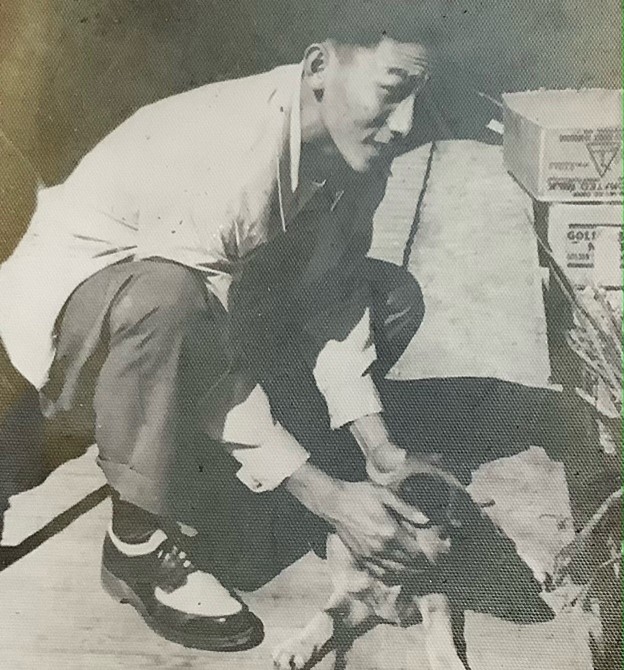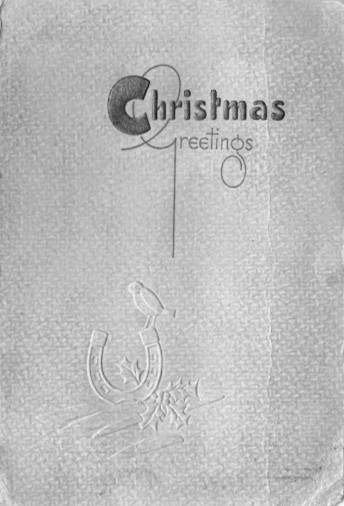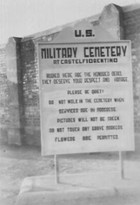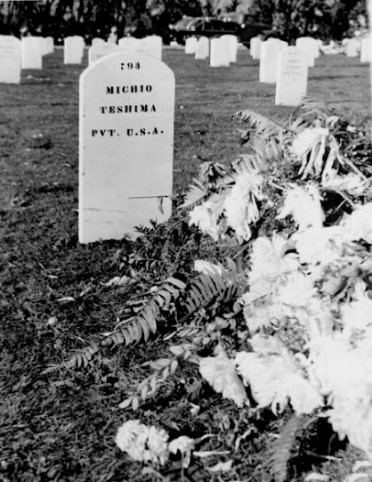
Michio Richard Teshima
Private
442nd Regimental Combat Team
100th Battalion, C Company
Michio Richard Teshima was born on March 8, 1923, in Riverside, California. He was the youngest of four sons of Yasuichi and Kameno (Kyosaki) Teshima. His brothers were John Yasuyoshi, Harry Tatsuo (or Toshio), and Henry Hisao. Michio was called Mich or Mitch by his family.
Father Yasuichi emigrated from Hiroshima, Japan, in 1905. In 1910, he was living in Soledad, Monterey County, and working on a beet farm. In 1915, he returned to Hiroshima and married Kameno who was still a teenager. They left Japan on the Shinyo Maru and arrived in San Francisco in January 1916. In 1917, the couple lived on Dufferin Avenue in Riverside, and Yasuichi was a gardener at the Arlington Heights Fruit Company.
By 1930, the family was living at 4403 Park Avenue in Riverside, and owned their home. Yasuichi was employed as the gardener at the Riverside Community Hospital. In 1940, they were living in their Park Avenue home, Yasuichi was employed at the hospital, Kameno was employed in a private home doing housework, and only the two youngest sons were still at home.
Michio graduated in 1940 from Riverside Polytechnic High School where he was an honor student and excelled in athletics, once scoring 47 points in a basketball game. He was remembered by one of his brothers as the most gregarious of the four Teshima sons, and although he was the youngest, he was not spoiled.
After the war began in December 1941, and Executive Order No. 9066 the following spring ordered the incarceration of Japanese Americans in the West Coast states, Yasuichi and Kameno and their three youngest sons were interned at Colorado River WRA camp, in Poston, Arizona. They entered on May 23, 1942, directly from home rather than through a WCCA Assembly Center. Their address at Poston was Block 4, Unit 9-A. Eldest son John Yasuyoshi was interned at Central Utah WRA relocation camp, also known as Topaz, after being evacuated to Tanforan WCCA Assembly Center in San Bruno, California.
A month after his internment, on June 30, 1942, Mitch signed his draft card at Local Board No. 1 in Yuma, Arizona. His address was Poston, and his home address was 4403 Park Avenue, Riverside. His point of contact was his father, also at Poston. He was 5’6” tall and weighed 130 pounds.
The family was released from Poston on different dates and to different places: Henry Hisao on September 23, 1942, to Lincoln, Nebraska; Harry Tatsuo on March 22, 1943, to Mitchell, Nebraska; Michio on June 15, 1943, to Detroit, Michigan; and the parents on July 2, 1943, to Birmingham, Michigan. John was released from Topaz on September 25, 1944, to Detroit.

Michio Teshima enlisted in the U.S. Army on April 4, 1944, at Fort Sheridan, near Chicago. His civilian occupation was listed as a technician/assistant and he had attended two years of college.
Mitch at the time he left for enlistment, 1944
Pvt. Teshima was sent to France in November 1944, as a replacement to the 442nd at the end of their participation in the Rhineland-Vosges Campaign, which after 25 days of heavy fighting and many casualties was undermanned. On November 17, the 442nd was relieved from the lines and ordered to proceed to Nice, on the southern coast of France. On November 19, they received 382 replacements fresh from training – among them Pvt. Teshima. The next day all of the men were loaded onto trucks for the trip to the coast, heading through Dijon, Avignon, Aix-en-Provence, and Cannes before reaching Nice. Private Teshima was assigned to the 100th Battalion, C Company.
After arriving in France, he wrote several letters to family. The first letter was addressed to Henry Teshima, Pioneer Camp, Lincoln, Nebraska:
Dear Henry, Thanks for the swell letter – I have arrived safely in France – everything is okay – Will be able to tell you more about everything later. Don’t worry too much about me – I’ll be okay. Be sure and write to the folks. Not too much to write about – will write again. Write via air mail. Be sure and cook up a nice fat steak for me. We’ll have dinner together after the war. Always, Mitch
About the same time, November 17, 1944, a letter addressed to Mrs. Y. Teshima, c/o R.V. Fobert, RFD 33, Birmingham, Michigan:
Dear Mother and Father, I don’t know how often I shall be writing to you from now on – so please do not worry about me if you do not hear from me too often. I hope that you both are in the best of health. Telephone John for me and give him my regards. We passed thru Paris the other night but was too dark to see very much. Regards to all. Thinking of you always. Your loving son – Mitch
The Combat Team’s mission in the Rhineland-Maritime Alps Campaign was to protect the right flank of the 6th Army Group and guard against a possible enemy breakthrough down the southern coast of France. The relatively calm time there enabled the Combat Team to rebuild its strength with the arrival of the fresh troops from the US. The 100th was stationed just east of Menton, on the coast very near the border with Monaco. This campaign was nicknamed the “Champagne Campaign.”

He sent a Christmas card to his brother Hank (Henry):
1944 Christmas card to Hank
From Mitch somewhere in France. A Merry Christmas and Happy New Year – Hank
While in southern France, on February 10, 1945, Teshima wrote to his brother Harry, who was a Private, Company D, School Battalion [MIS Language School], Camp Snelling, Minnesota:
Dear Harry, Thanks for your many letters. Everything is okay here. How are you making out over at school – okay, I suppose. If and when this damn war ends, I’m certainly going back to four years of college, and no foolin’ – someday, I guess. Not too much to write. Take care of yourself – Mitch
February 22, 1945, Teshima wrote again to his brother Harry:
Dear Harry – Hello – Thanks for the photo – you look swell. I plan to take one someday – meanwhile I sent a snap to the folks – not much good though – I’m all dirty and messy. Well, I see you’re getting along okay at Snelling – hope the war finishes before they ship you out. Things are okay over here – am in good health. I find that the French dames are not bad either – they’re awfully easy to get along with. However, no matrimonial intentions as yet. As Hank said, ‘There’ll be a double killing if I ever come back with one.’ However, am getting rather proficient in slinging that French out. I hear all our homegrown peaches are being married off – Laugh, eh! Well, enough for now – am writing to the folks about once a week. Take care of yourself – Always, Mitch
After spending the winter in southern France, the 442nd RCT (minus the 522nd Field Artillery Battalion sent to fight in Germany) was sent to Italy. They arrived at their staging area at Marseilles on March 17-19 and sailed on March 20-22 for Pisa. On March 25, the 442nd arrived at the Peninsular Base Section Staging Area at 4:00 p.m. and was attached to the Fifth Army.
Their participation in the Po Valley Campaign was a closely guarded secret. The objective of the 442nd was to launch a surprise diversionary attack on the western anchor of the German Gothic Line, causing the Germans to send their reserve forces to defend against the 442nd attack. The center of this elaborate system of fortifications had been attacked in the fall of 1944, but no one had yet been able to pry the Germans loose from the western end. The Gothic Line in this area was hewn out of solid rock, reinforced with concrete, and constructed to give all-around protection and observation. The Germans were dug into mountain peaks rising almost sheer from the coastal plain, bare of vegetation save for scanty scrub growth. They had to be cleared out of this area in order for the Allies to move farther north. The enemy had been upgrading their forces for three weeks in March, bringing in veteran troops and five crack infantry battalions.
On March 28, the Combat Team left their staging area in Pisa and moved to a bivouac at San Martino, near the walled city of Lucca. While at this bivouac, replacements such as Private Teshima, who had seen little or no combat, were engaged in practicing small-unit problems with their squads and platoons.
Starting at 7:45 p.m. on April 3, the 100th and the 3rd Battalions moved under cover of darkness to forward assembly areas. Private Teshima, with the 100th, moved into the vicinity of Vallechia. The next day, April 4, the soldiers remained hidden in houses and olive groves.
On the night of April 4, unbeknownst to the Germans, the 100th Battalion moved up to its line of departure on the hill mass the Allies called Florida, where they relieved elements of the 371st Infantry. Florida was the southernmost of a series of saw-tooth hills culminating at Mount Folgorito – the others were designated Georgia, Ohio 1, Ohio 2, and Ohio 3. At the same time, the 3rd Battalion began its climb up the saddle between the 2,800-foot Mount Folgorito and the 3,000-foot Mount Carchio.
That evening, Teshima spent time reminiscing with a high school friend, Tec/3 Harold Harada, 100th Battalion Medics. As Harada later recalled:
By sheer luck, we met while getting ready to go to chow. The kitchen crew made a special hot dinner of pork chops, rice, and pineapples because they knew we were going into a big offensive… He was a very nice young man, honest and upright, and he never spoke badly of anyone… [He] was from a good family – his father, a gardener, was a pillar of the community, an Issei leader. We talked for about 45 minutes, shook hands, and said ‘good luck,’ and we then moved up to our respective forward units.
The morning of April 5, as 3rd Battalion conducted their surprise attack on the enemy at Folgorito/Carchio, the 100th Battalion began its attack north at 5:00 a.m. behind a tremendous demonstration of artillery power. Their first objective was the peak called Georgia, a knob of solid rock with at least 15 German gun emplacements. The leading men had advanced about 150 yards toward their objective when someone tripped a mine. In the scramble for cover, seven more mines went off, which caused heavy casualties and brought down grenades and machine-gun fire from the enemy. The attack faltered and stopped; however, thanks to the heroic actions of the 100th, by 5:20 a.m. they had gained the crest of Georgia.
The 100th continued toward the first of the Ohio peaks as the enemy threw heavy concentrations of mortar and artillery fire at them. Finally, the 100th men were forced to filter through the heavy fire and close in to hand-grenade range. The battle raged furiously all day on April 5, as the bunkers had to be destroyed one by one. After a strong enemy counterattack at midnight, an hour-long firefight at close range ensued and the Germans finally pulled back. The cost to the 100th was 20 men killed and 123 wounded.
Private Michio Teshima was killed this day – April 5, 1945. It was reported that he was killed in the early morning hours in a mortar barrage. Indeed, according to his nephew, the family believes he “was a scout and likely one of the first to face the mortars.”
The hospital admission card notes only that he was killed in action/combat with no mention of the causative agent, indicating that he died on the battlefield rather than in the aid station. There were nine other men of C Company killed that day, in addition to many wounded.

Private Michio Teshima was buried in Site #793 in the U.S. Military Cemetery at Castelfiorentino, Italy.
Entrance to U.S. Military Cemetery at Castelfiorentino
From the photo, it appears that his grave was visited near the end of the 442nd occupation and many flowers placed there.

initial tombstone of Private Teshima, December 7, 1945
For his World War II service, Private Michio Richard Teshima was awarded the following: Bronze Star Medal, Purple Heart Medal, Good Conduct Medal, European-African-Middle Eastern Campaign Medal with two bronze stars, World War II Victory Medal, Distinguished Unit Badge, and Combat Infantryman Badge. He was posthumously awarded the Congressional Gold Medal on October 5, 2010, along with the other veterans of the 100th/442nd Regimental Combat Team. This is the highest Congressional Civilian Medal.
After the war, most of the overseas military cemeteries were closed. Families of the fallen soldiers were given the choice of having their loved one reinterred in one of the few remaining cemeteries or returned home. The Teshima family chose to have Michio’s remains returned to the US. He was buried at Golden Gate National Cemetery in San Bruno, California, Plot J, Site 793, on December 16, 1948. The site number is coincidentally the same number as his gravesite number in Castelfiorentino.
Mitch Teshima’s parents became US citizens on December 21, 1953, at the Detroit District Court in Michigan. His brother Harry named one of his sons after his brother Michio Richard.
His name appears on a memorial plaque at the site of Poston WRA Camp dedicated on October 6, 1992. On May 31, 1997, a dedication ceremony was held in downtown Riverside for the Military Roll of Honor Memorial for the county’s war dead. Private Teshima’s name was among the 775 names on the memorial.
Researched and written by the Sons & Daughters of the 442nd Regimental Combat Team with assistance by his nephew in 2023.
